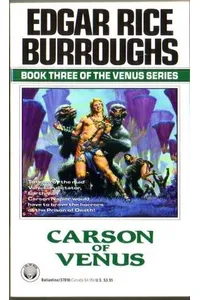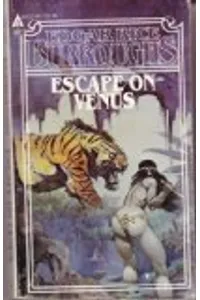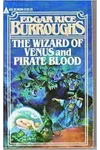Step into the misty, thrilling world of Venus, where sky-high trees, warring kingdoms, and daring adventures await! Edgar Rice Burroughs’ Venus series, also known as the Amtor series, is a science fantasy saga that transports readers to a lush, perilous planet. Follow Carson Napier, an Earth-born hero, as he crash-lands on Venus and battles exotic creatures, rescues princesses, and wins the heart of the fearless Princess Duare. With its vibrant world-building and pulse-pounding escapades, this series is a hidden gem for fans of classic pulp adventure.
Unlike the desert sands of Burroughs’ famous Barsoom (Mars) series, Venus is a waterworld teeming with life. Its cloud-shrouded landscapes and vibrant cultures make every page a thrilling escape. Ready to explore a forgotten classic? Let’s dive into the heart of Amtor!
How Venus Began
Edgar Rice Burroughs, the mastermind behind Tarzan and John Carter, launched the Venus series in 1932 with Pirates of Venus. Already a titan of pulp fiction, Burroughs wanted to craft a new planetary adventure, blending science fiction with swashbuckling fantasy. Inspired by the mysterious allure of Venus, then thought to be a cloudy, jungle-like world, he created Amtor—a planet of endless oceans, towering forests, and clashing civilizations. The series, serialized in Argosy magazine, marked Burroughs’ final major saga, showcasing his knack for vivid storytelling.
Carson Napier, the series’ bold yet relatable protagonist, was born from Burroughs’ desire for a hero distinct from the superhuman John Carter. A navigational error sends Carson hurtling to Venus instead of Mars, setting the stage for a saga filled with romance, danger, and political satire. Burroughs’ love for adventure and his playful take on science made Venus a unique addition to his legacy.
The Heart of Venus
The Venus series spans five core books, each brimming with action and exotic locales. Pirates of Venus (1934) introduces Carson Napier, who crash-lands on Amtor and allies with the Vepajans, a displaced people, while falling for Princess Duare. In Lost on Venus (1935), Carson and Duare face monstrous creatures and treacherous kingdoms, deepening their bond. Carson of Venus (1939) takes a satirical turn, poking fun at fascism through the Zani regime, a nod to Nazi Germany, while Carson fights to save Duare. Escape on Venus (1946), an episodic tale, sees the duo battling fishmen, cloud people, and more. Finally, The Wizard of Venus (1970), published posthumously, wraps up Carson’s adventures with a mystical twist.
The series’ themes are classic Burroughs: heroism, romance, and the clash of civilizations. Amtor’s waterworld setting, with its islands like Vepaja and city-states like Havatoo, feels alive with strange creatures and complex societies. Burroughs weaves political commentary—satirizing communism in the Thorists and fascism in the Zanis—into his fast-paced plots. The prose, while dated, crackles with energy, making Venus a perfect escape for readers craving action and wonder.
Carson’s journey is less about superhuman feats and more about wit and courage, making him a grounded hero. Duare, though bound by her culture’s traditions, grows into a fierce partner, adding depth to the series’ romantic core. Together, they navigate a world where danger lurks behind every cloud, from eugenicist utopias to zombie-haunted cities.
Why Venus Resonates
Though less famous than Tarzan or Barsoom, the Venus series left its mark on the sword-and-planet genre. Its blend of science fantasy and pulp adventure inspired later writers, while its vivid world-building captivated readers of the 1930s and beyond. Fans on platforms like Goodreads praise its escapist charm, calling it “comfort food” for sci-fi lovers. The series’ political satire, especially in Carson of Venus, showed Burroughs tackling real-world issues, adding surprising depth to his pulp roots.
Today, Venus endures as a nostalgic treasure, with reprints and new novels like Carson of Venus: The Edge of All Worlds (2020) expanding the saga. Its influence lingers in the adventurous spirit of modern sci-fi, proving Burroughs’ knack for crafting worlds that spark the imagination. For fans of classic fantasy, Venus is a portal to a bygone era of storytelling.
- Publication Years: 1934–1970 (core series)
- Number of Books: Five, plus modern expansions
- Genre: Science fantasy, sword-and-planet
Ready to soar through the clouds of Amtor? Grab Pirates of Venus and dive into a world of swashbuckling adventure, romance, and alien wonders!




